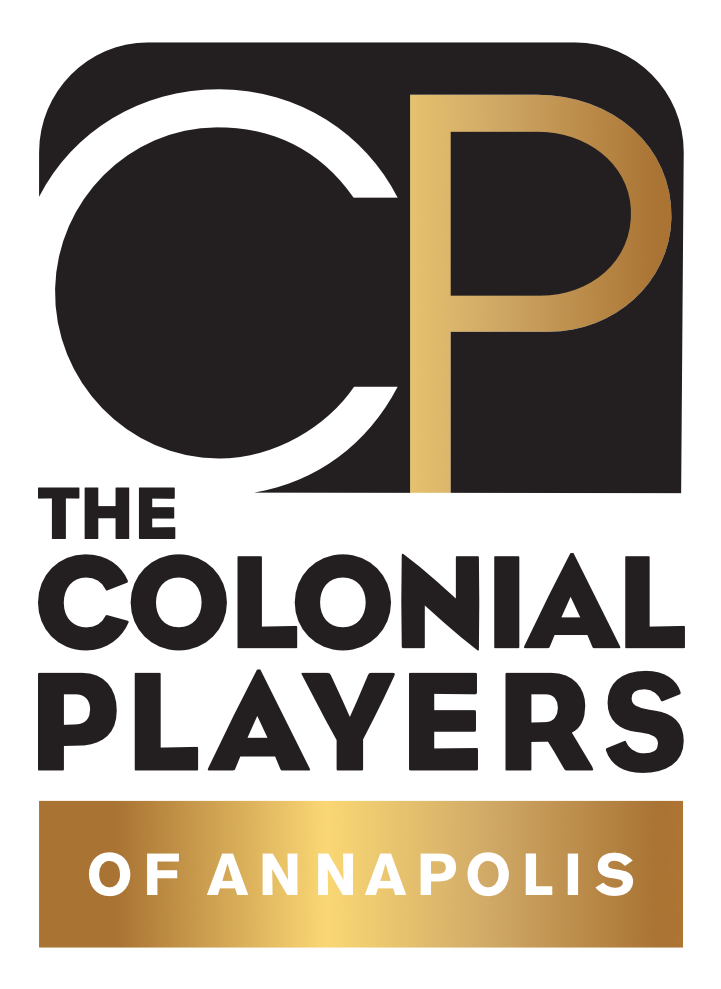- Published: 15 April 2019
- Hits: 2493
Curious about that mini Grand Piano on our stage for A New Brain? This piano was graciously loaned to us by Director Alicia Sweeney for use in our production. Manufactured by Samick, this Model SG500 piano is a digital version of a grand piano in a much smaller and more convenient footprint. It turned out this unit was not only perfect for Alicia’s artistic vision for the show, but also perfect for incorporating the various special effects our design team wanted.
Because the piano has to do a substantial amount of movement around our stage, frequently with an actor aboard, a new custom-designed base was carefully constructed by Piano Effects Designer Wes Bedsworth, Producer Tim Brown, and Lead Carpenter Ted Yablonski. This new base provides stronger legs and support to accommodate the force while rolling on the stage, and protects the overall structure of the piano. Custom internal supports were constructed to allow the piano to withstand the weight of an actor.
When the piano is actually played “live” by Gordon, the audio comes from our house sound system rather than the piano itself. This is by design to spread the audio evenly in our space, and this electronic piano model was perfect for our needs! Wes evaluated the piano and worked to temporarily disable the the internal amplifier for the show and remove the speakers to make room for other additions that are detailed later on. Among those additions is a wireless audio transmitter. This transmitter receives the digital audio from the piano and broadcasts it to our house sound system where it can be controlled from the Tech Booth.
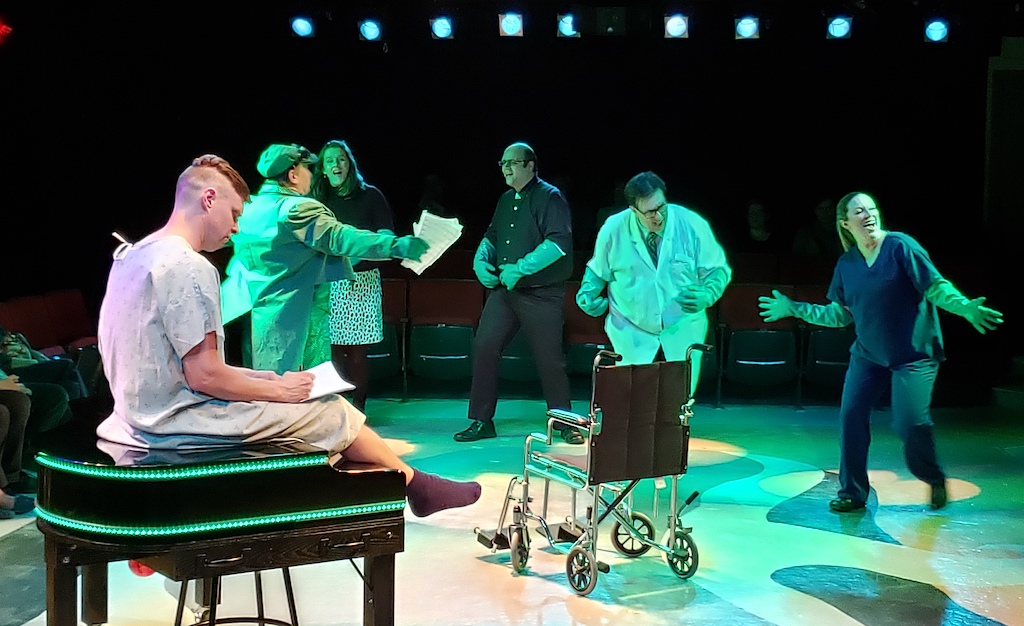 You’ll no doubt notice the lighting effects on the piano. To really tell Gordon's story, the piano needed to be able to transform from a piano to a bar table to an ambulance to an operating table to a hospital bed to an MRI to… well, the list goes on. Lighting plays a crucial role in theatre, and this piano is no exception.
You’ll no doubt notice the lighting effects on the piano. To really tell Gordon's story, the piano needed to be able to transform from a piano to a bar table to an ambulance to an operating table to a hospital bed to an MRI to… well, the list goes on. Lighting plays a crucial role in theatre, and this piano is no exception.
If you just wanted to know the basics of the cool tech that supports our show, you can stop here. But for the technical nitty-gritty, read on!
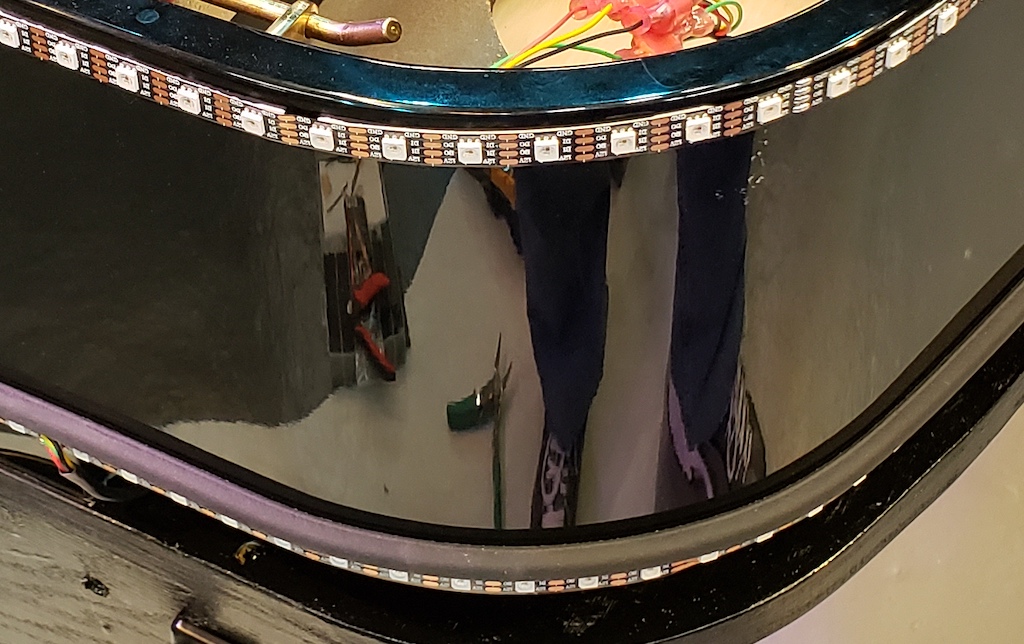 Wrapped around the outside edges of the piano are WS2813 LED pixels (also frequently referred to as “NeoPixels”). These LEDs come on a roll and are individually controllable in 24-bit color allowing for a designer to not only vary the color, but control it one “pixel” at a time, making possible the wide range of animations and effects you’ll see today. There is not an off-the-shelf controller available for these pixels capable of what we needed, however, so one had to be designed, built, and programmed.
Wrapped around the outside edges of the piano are WS2813 LED pixels (also frequently referred to as “NeoPixels”). These LEDs come on a roll and are individually controllable in 24-bit color allowing for a designer to not only vary the color, but control it one “pixel” at a time, making possible the wide range of animations and effects you’ll see today. There is not an off-the-shelf controller available for these pixels capable of what we needed, however, so one had to be designed, built, and programmed.
For our recent production of Silent Sky, production team members Richard Atha-Nicholls and Ernie Morton experimented with the use of NeoPixels suspended from the ceiling to represent stars via a wired network control application with some basic source code loaded onto an Adafruit METRO 328 Arduino controller. This initial application opened our eyes to possibilities for future shows. For A New Brain, we now needed a wireless network controller that additionally provided substantially more animation capability. Starting where Richard and Ernie left off, Wes began working with Lighting Designer John Purnell to research what specific type of LED pixel strip should be used. There are various types with different voltages and features. Settling on a 12-volt RGB (red-green-blue) version, Wes continued research and development work over the course of about 8 weeks to design, assemble, and test the “electronics package” for the piano capable of the effects you see today, as well as writing almost 2500 lines of C++ code to make it operate and communicate.
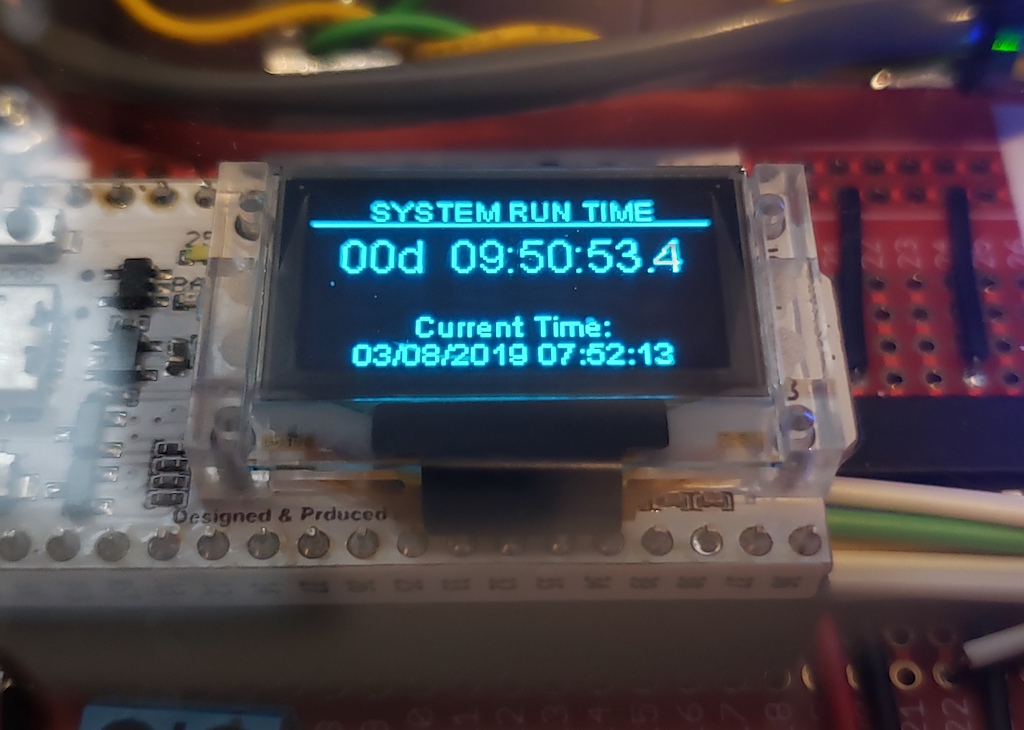 One of the challenging parts of this process was the wireless control aspect. Of four different types of Arduino-based controllers considered for this project, only one met our requirements: an ESP32 variant by HiLetgo which includes a dual-core 250MHz processor and a substantial amount of memory (by Arduino standards). In addition to being very small (⅓ the size of a credit card), this controller has power and flexibility not available in other variants, as well as a 1-inch fully customizable screen!
One of the challenging parts of this process was the wireless control aspect. Of four different types of Arduino-based controllers considered for this project, only one met our requirements: an ESP32 variant by HiLetgo which includes a dual-core 250MHz processor and a substantial amount of memory (by Arduino standards). In addition to being very small (⅓ the size of a credit card), this controller has power and flexibility not available in other variants, as well as a 1-inch fully customizable screen!
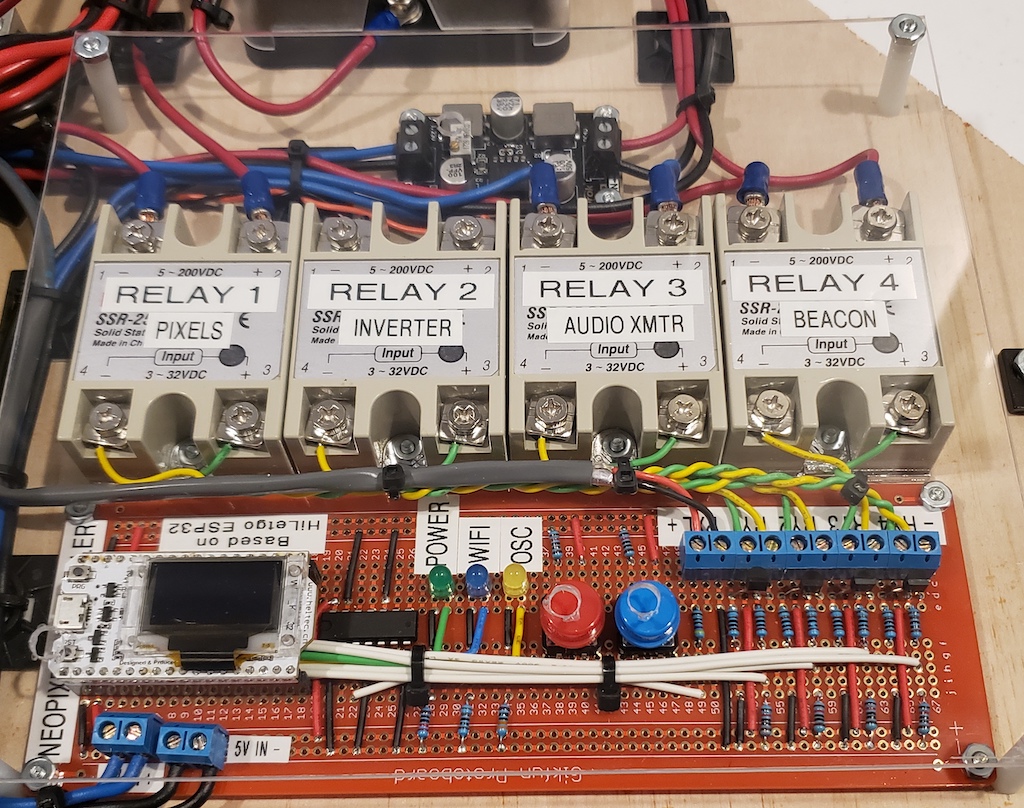 To integrate the electronics package in our production, it had to be capable of interfacing with Figure 53's QLab (our theatrical cueing software that manages all of the technical aspects of our shows). To achieve this capability, a custom implementation of Open Sound Control (OSC) - a flexible communication protocol used for a variety of theatrical control applications - was incorporated into the design. Additional capability was added to facilitate power management over the piano, a motorized light, and the LED strip to ensure we wouldn’t drain the batteries too quickly!
To integrate the electronics package in our production, it had to be capable of interfacing with Figure 53's QLab (our theatrical cueing software that manages all of the technical aspects of our shows). To achieve this capability, a custom implementation of Open Sound Control (OSC) - a flexible communication protocol used for a variety of theatrical control applications - was incorporated into the design. Additional capability was added to facilitate power management over the piano, a motorized light, and the LED strip to ensure we wouldn’t drain the batteries too quickly!
Dan McMath from Poulsbo, Washington, who has extensive experience programming Arduino-based controllers, consulted on this project. Separated by almost 3,000 miles, Wes and Dan worked on the design and coding for this project collaboratively near-daily for 8 weeks when not at their respective day jobs. The added challenge of a 3-hour time difference made this even more fun. They not only developed and coded the lighting effects algorithms, but also created hardware control algorithms, designed a user interface, and accounted for WiFi connection and drop-out handling, among many other considerations.
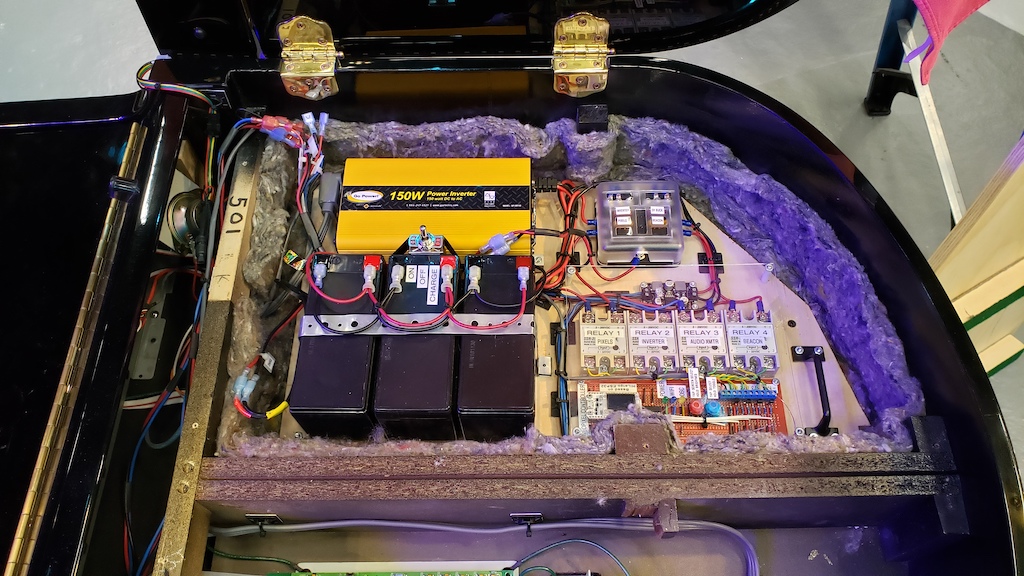 What on the surface may look like a relatively standard set piece (a piano) with a few lights attached actually has quite a bit of custom electronics “under the hood” to enable seamless integration into the musical you’ll see today. Something that was merely a concept only a few months prior to opening night has become a reality before our audiences on the stage, and we hope that the effort illuminates (pun intended) the unique story of the show for you and your fellow patrons. Of note is the fact that all of this work was completed with no permanent modifications to the original piano, allowing it to be easily reassembled to its original state following this production... although Alicia has indicated that she may want to keep the lights so brighten up her home on a rainy day...
What on the surface may look like a relatively standard set piece (a piano) with a few lights attached actually has quite a bit of custom electronics “under the hood” to enable seamless integration into the musical you’ll see today. Something that was merely a concept only a few months prior to opening night has become a reality before our audiences on the stage, and we hope that the effort illuminates (pun intended) the unique story of the show for you and your fellow patrons. Of note is the fact that all of this work was completed with no permanent modifications to the original piano, allowing it to be easily reassembled to its original state following this production... although Alicia has indicated that she may want to keep the lights so brighten up her home on a rainy day...
If you’d like to take a close-up look at the piano, feel free to ask one of our Stage Managers, Shirley Panek or Bernadette Arvidson. Also available at most performances is designer Wes Bedsworth who can answer any questions you may have about the development and integration of the control hardware itself.
